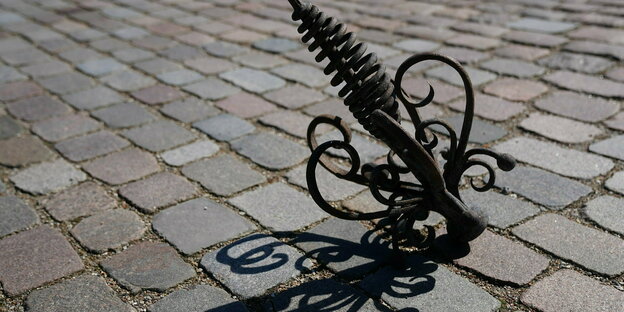For many people in Denmark, the collapse of the Dragon Tower was their own Notre Dame moment. But there are also bright spots in the catastrophe.

The iconic spire of the Old Copenhagen Stock Exchange Photo: Ida Marie Odgaard/dpa
The next day, Brian Mikkelsen holds the soot-blackened top of the legendary Dragon Tower in his hand. A security guard found him in the rubble and ran over with him. “I promised him that he would come back up,” Mikkelsen tells Danish radio DR with audible emotion. The director of the employers' organization Dansk Erhverv takes advantage of the moment to reiterate his statement from the day before: The historic Copenhagen Stock Exchange, since then. 2007 The organization's headquarters must be rebuilt at any cost.
The fire department was alerted at 7:36 a.m. Tuesday morning and was on scene after four minutes. They were unable to prevent the people of Denmark from witnessing the collapse of the Dragon Tower. “Our own Notre Dame moment,” Danish Defense Minister Troels Lund Poulsen wrote in X. He was not the only one to make this comparison. Exactly five years earlier, the spire of the Paris cathedral collapsed in a huge fire.
The Dragon Tower was part of Copenhagen's cityscape for almost 400 years, so for centuries it stood above the old Stock Exchange building. Four intertwined dragon tails (!), surmounted at the conical end by three crowns, one for Denmark, one for Norway and one for Sweden. Looking at this idiosyncratic landmark, consciously or casually, is a given for the people of the Danish capital, part of the certainty of being home. And a tourist attraction that the city advertises. Until Tuesday, Børsen, completed in 1625, was one of the oldest surviving buildings in Copenhagen. It has been restored over two years to shine like new for the anniversary.
The Visit Copenhagen tourist board website for the stock exchange only provides brief information: “This page is not currently being updated. It will only be changed when the full magnitude of the fire is known. Beneath it lies a happy past: the building is “a central sight on the horizon.” We learn that King Christian IV recognized the growing importance of trade and had this “great building” built in the style of the Dutch Renaissance.
Bright spots in the catastrophe
And the tower? There is a special legend surrounding it: it is said to protect the building from enemy attacks and fires. And, in fact, over the centuries, the old Stock Exchange was “mysteriously” saved from fires in its vicinity on several occasions. Until April 16, of course. A police spokesman said Wednesday that it could take months for the cause of the fire to be clarified. What is clear, however, is that half of the old Stock Exchange burned to the ground, including the historic trading floor.
“It's a terrible sight,” Mikkelsen said Tuesday. The mixture of old wooden structures and a copper roof, under which a lot of heat accumulates, complicated the extinction. “A fire like this is our biggest nightmare,” fire department operations director Frank Trier Mikkelsen told TV2 News.
Three positive points from the disaster: 1. There were no injuries. 2. Hundreds of important works of art were published on time, including those by individuals who spontaneously switched to hero mode on the way to work. 3. The Spire Spire is back. Marked but recognizable. This should be a small comfort to the people of Copenhagen the day after the great horror.
